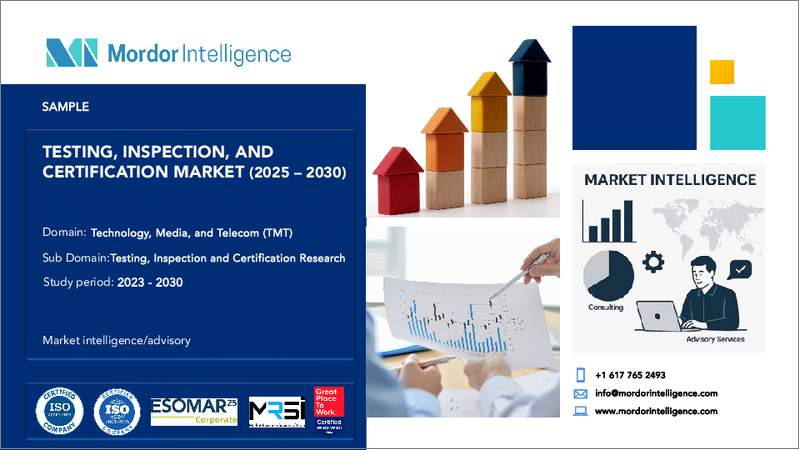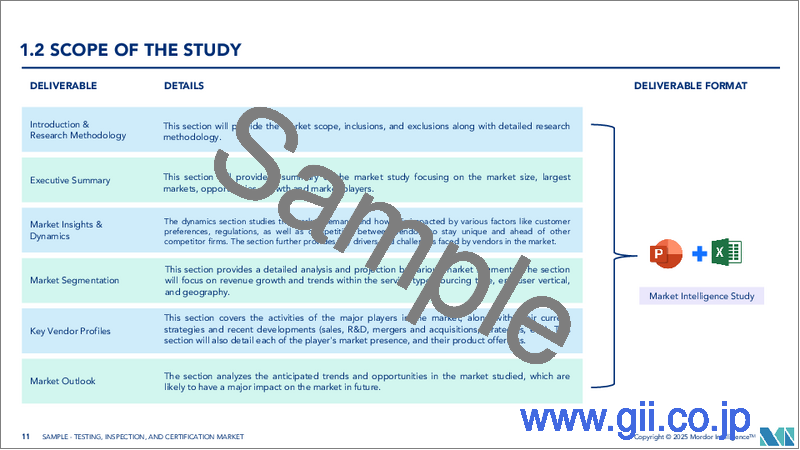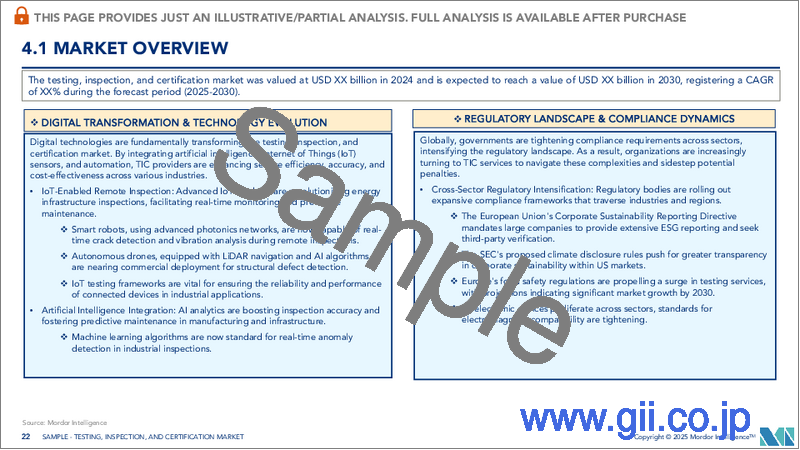|
|
市場調査レポート
商品コード
1687747
試験・検査・認証(TIC):市場シェア分析、産業動向・統計、成長予測(2025年~2030年)Testing, Inspection, And Certification - Market Share Analysis, Industry Trends & Statistics, Growth Forecasts (2025 - 2030) |
||||||
カスタマイズ可能
適宜更新あり
|
|||||||
| 試験・検査・認証(TIC):市場シェア分析、産業動向・統計、成長予測(2025年~2030年) |
|
出版日: 2025年03月18日
発行: Mordor Intelligence
ページ情報: 英文 220 Pages
納期: 2~3営業日
|
全表示
- 概要
- 目次
試験・検査・認証(TIC)市場規模は、2025年に2,634億米ドルと推定され、予測期間(2025-2030年)のCAGRは4.68%で、2030年には3,310億8,000万米ドルに達すると予測されます。

試験には、特定の手順に従って対象物やシステムの1つまたは複数の特性を決定することが含まれます。製品やシステムの性能、機能性、信頼性、その他の関連する側面を評価するプロセスです。試験は試験所または現場で実施され、欠陥、弱点、規格や要件への不適合を特定するのに役立ちます。
検査は、製品の設計、工程、設置などを精査し、定められた規格への準拠を確認するものです。このプロセスでは、製品の物理的特性、操作能力、規制への適合性を詳細に評価します。検査は極めて重要であり、生産中、設置中、定期的なメンテナンス中など、さまざまな局面で実施され、必要な規格やガイドラインとの整合性が保証されます。
世界のエネルギー・電力セクターは現在、大きな転換期を迎えています。この転換の主な動機は、気候変動との戦い、エネルギー効率の向上、持続可能な未来の確保という要請です。近年、エネルギー効率の高いプロセスへの投資が急増しています。この変化の背景には、温室効果ガス排出量の削減、エネルギー消費量の削減、運用コストの削減の必要性など、さまざまな要因があります。エネルギー効率の高いプロセスには、高度な断熱材、エネルギー効率の高い照明システム、高効率HVACシステムなど、幅広い技術が含まれます。
近年、環境汚染の問題は世界的に大きな注目を集めています。この問題の主な原因のひとつは自動車部門であり、自動車の排出ガスが重要な役割を果たしています。
自動車の排ガス試験と認証が重視されるようになった主な理由は、自動車の排ガスが環境に与える有害な影響です。一酸化炭素、窒素酸化物、粒子状物質のような有害汚染物質は、大気汚染と気候変動の原因となっています。これらの汚染物質は大気の質を悪化させるだけでなく、オゾン層の破壊にもつながります。政府は、厳しい排出基準や試験方法を実施することで、こうした環境上の危険を軽減することを目指しています。
近年、TIC市場では、さまざまな業界にわたって規制、基準、認証が急増しています。その結果、複数の利害関係者、供給業者、製造業者、流通業者を含むサプライ・チェーンがより複雑化し、相互に接続されるようになりました。世界化もまたこの複雑さを増幅させており、製品はさまざまな地域から調達され、それぞれが規制の対象となっています。
現在のシナリオでは、マクロ経済情勢は依然として不安定であり、プレーヤーは、高金利、インフレ、景気後退懸念、地政学的緊張の高まりといったマクロ動向が世界の一部で引き続き見られると見ており、これらは将来の産業活動やTIC市場の製品需要に影響を与える可能性があります。2024年4月、国連貿易開発会議(UNCTAD)は、世界経済の成長率が2.6%に鈍化し、一般的に景気後退とされる2.5%をわずかに上回ると予測しました。
試験・検査・認証(TIC)市場の動向
エネルギーと化学が最大のエンドユーザー市場に
- 潜在的な危険性を考慮すると、エネルギー・化学品セクターでは安全性が最優先事項です。TICサービスは、安全規制や業界標準への準拠を検証するのに役立ちます。例えば化学業界では、TICはパイプライン、貯蔵タンク、掘削装置の完全性を保証し、事故のリスクを最小限に抑えます。TICは、製造プロセスや危険物質の取り扱いの安全性を評価するのに役立ちます。
- TICのサービスは、エネルギー・化学品分野全体の製品品質維持に不可欠です。厳格な試験、検査、認証を通じて、TICは製品が要求される基準を満たしていることを保証します。再生可能エネルギー分野では、TICはソーラーパネル、風力タービン、エネルギー貯蔵システムの性能と耐久性を検証します。化学製品では、TICは純度、組成、品質仕様への準拠の評価を支援します。
- エネルギー・化学品セクターでは、持続可能性と環境責任が今や極めて重要です。TICのサービスは、操業による環境への影響を評価し、最小限に抑えることを支援します。環境試験は、汚染物質の特定、大気、水質、土壌のモニタリングに役立ちます。TICはまた、排出規制や廃棄物管理などの環境規制の遵守もサポートします。
- TICサービスは、サプライチェーン全体で製品の完全性とトレーサビリティを維持するために不可欠です。これには、原材料の原産地と品質の確認、生産のさまざまな段階での検査の実施、輸出や流通のための最終製品の認証などが含まれます。
- エネルギー・電力部門では、事故を防止し、労働者を保護し、安全な作業環境を維持するために、安全検査が極めて重要です。これらの検査では、設備、機械、インフラに潜在的な危険がないかどうかを評価します。火災安全検査、電気安全監査、ガス漏れ検知は、リスクを特定し、是正措置を実施するために実施される安全検査の一部です。
- 2023年11月、スコティッシュパワー・リニューアブルズ社はDNVと3年間の契約を締結しました。DNVは、イースト・アングリア・スリー・プロジェクトのための統合検査サービスを提供します。その範囲には、2026年まで世界中のプロジェクトとベンダーの両方のサイトにわたるサイト検査、ベンダー評価、品質管理サービスが含まれます。イースト・アングリア・ハブのマネージング・ディレクターによると、イースト・アングリア・スリーは、2026年の運転開始時には世界第2位の風力発電所になるといいます。イースト・アングリア・スリーは、英国のエネルギー安全保障を強化し、クリーンで再生可能なエネルギーを供給する上で重要な役割を果たすと期待されています。
- 世界・エネルギー・モニターの報告書によると、2024年6月には、中国が主に洋上で129基の風力発電所を稼働させ、世界をリードしています。中国に続き、洋上ウインドファームの存在感が大きい国は、英国、ドイツ、ベトナムなどです。洋上風力発電は、陸上風力発電に比べ、より強い風速の恩恵を受け、発電量が増加します。SSRは風力タービンの制御システムにおいて重要であり、ブレードのピッチとヨーの方向調整を容易にします。その正確で信頼性の高い動作は、タービンの性能を最大化し、風力エネルギーを効率的に取り込むために不可欠です。
大きな成長を記録するアジア太平洋地域
- 中国は市場の成長に大きく貢献しています。同国は、自国産業の発展とそれに伴う輸出の加速、厳格な基準の導入、急速な都市化を通じて魅力的なスポットとなり、同国におけるTICのさまざまな機会を生み出しています。
- 中国の「メイド・イン・チャイナ2025」構想は、5Gを新興産業として位置づけています。これは、中国企業が国際市場で競争力と革新性を高め、低品質品や競合品の市場参入を防ぐ機会を提供するもので、分野別認証を通じて実現できます。
- 中国政府は、段階的な自由化を推進するため、外国企業の進出を認める有益な政策を実施しています。中国各省のTIC市場の大半は地元企業が占めています。政府は、国際的なTICプロバイダーが中国本土市場に参入し機能するための障害を取り除くことで、TICセクターへの外国投資を促進してきました。
- 例えば、2024年4月、MPR China Certification GmbHとその子会社であるMPR International GmbHおよびChina Certification Corporationは、CERTANIAとの戦略的提携を明らかにしました。この急速に拡大するグループは、試験・検査・認証(TIC)サービスを専門としています。この提携はMPRにとって重要な成果を意味し、同社の成長イニシアチブを加速させる。
- 2050年までのカーボンニュートラルを目指して、日本政府は一連のエネルギー政策を発表しました。これらの政策は、電力、産業、運輸を含む主要部門における温室効果ガスの大幅削減を目標としています。特に、政府は電力部門について野心的な2030年目標を設定しています。この目標には、再生可能エネルギー発電への投資を拡大し、原子力発電を強化し、化石燃料による電力生産を縮小することが含まれています。
- 電力・エネルギー分野におけるさまざまな開発が、市場開拓の機会を生み出すと期待されています。例えば、2024年4月、GE Vernovaのガス発電事業は、韓国電力公社(KEPCO)の子会社である韓国西部電力(KOWEPO)から、韓国忠清南道公州市にあるKOWEPOの発電所向けにGE Vernova7HA.02ガスタービンとH65発電機を受注したと発表しました。
- 都市化の進展、人口動態の変化、小売業の着実な成長が、インドの食品加工産業の成長を後押ししています。こうした需要の増加により、飲食品企業の生産が急増しています。これらの企業は、新製品の投入や既存製品ラインの拡大により、中間層の人口増加に乗じており、市場の成長を支えています。
試験・検査・認証(TIC)業界の概要
世界の試験・検査・認証(TIC)市場は、Intertek Group PLC、SGS SA、Bureau Veritas、UL Solutions Inc、DNV AS、Eurofins Scientific SE、Dekra SE、ALS Limitedなど様々な企業が存在し、細分化されています。調査対象の試験・検査・認証(TIC)市場における競争企業間の敵対関係は激しく、予測期間中もその傾向は変わらないと予想されます。
既存および新規市場の既存企業はデジタル革新戦略を採用しています。各社は、市場競争の激化が予想される大規模な合併・買収活動に取り組んでいます。既存のTIC企業は、予測される市場成長、世界化の進展、デジタル化動向の高まりを考慮し、予測期間中も拡大や製品革新活動を中核戦略に組み込んでいくとみられます。
全体として、市場競争は激しくなると予想されます。今後数年間は高い統合が予想され、競争企業間の敵対関係はさらに高まると思われます。
その他の特典:
- エクセル形式の市場予測(ME)シート
- 3ヶ月間のアナリストサポート
目次
第1章 イントロダクション
- 調査の前提条件と市場定義
- 調査範囲
第2章 調査手法
第3章 エグゼクティブサマリー
第4章 市場洞察
- 市場概要
- 業界の魅力度-ポーターのファイブフォース分析
- 供給企業の交渉力
- 消費者の交渉力
- 新規参入業者の脅威
- 代替品の脅威
- 競争企業間の敵対関係
- マクロ経済要因とCOVID-19がTIC産業に与える影響
第5章 市場力学
- 市場促進要因
- エネルギー効率化プロセスへの投資の増加とエネルギー・電力分野におけるスマートグリッドの利用の増加
- 自動車排ガス試験と認証の増加
- 市場抑制要因
- サプライチェーンの複雑化による評価プログラムのリードタイム増加
第6章 NDTサービス産業の分析
- 現在の市場需要
- 市場内訳
第7章 市場セグメンテーション
- サービスタイプ別
- 試験・検査サービス
- 認証サービス
- 調達タイプ別
- アウトソーシング
- インハウス
- 業界別
- 消費財・小売
- 食品・農業
- 石油・ガス
- 建設・エンジニアリング
- エネルギー・化学
- 工業製品製造
- 運輸(航空宇宙、鉄道)
- 工業および自動車
- その他エンドユーザー業界別
- 地域別
- 北米
- 米国
- カナダ
- 欧州
- 英国
- ドイツ
- フランス
- スペイン
- ノルウェー
- アジア
- 中国
- 日本
- 韓国
- インド
- オーストラリアとニュージーランド
- ラテンアメリカ
- ブラジル
- メキシコ
- 中東・アフリカ
- サウジアラビア
- アラブ首長国連邦
- カタール
- トルコ
- ナイジェリア
- 北米
第8章 競合情勢
- 企業プロファイル
- Intertek Group PLC
- SGS SA
- Bureau Veritas SA
- UL Solutions Inc.
- DNV GL
- Eurofins Scientific SE
- Dekra SE
- ALS Limited
- BSI Group
- CIS Commodity Inspection Services BV
- MISTRAS Group Inc.
- Element Materials Technology(Temasek Holdings)
- TUV SUD
- Applus Services SA
- Kiwa NV
第9章 投資分析と市場展望
The Testing, Inspection, And Certification Market size is estimated at USD 263.40 billion in 2025, and is expected to reach USD 331.08 billion by 2030, at a CAGR of 4.68% during the forecast period (2025-2030).

Testing involves the determination of one or more characteristics of an object or system according to a specific procedure. It is the process of evaluating the performance, functionality, reliability, and other relevant aspects of a product or system. Testing can be conducted in laboratories or on-site, and it helps identify any defects, weaknesses, or non-compliance with standards or requirements.
Inspection entails scrutinizing a product's design, process, or installation to verify its adherence to defined standards. This process involves a detailed assessment of a product's physical characteristics, operational capabilities, and regulatory compliance. Inspections are pivotal and can occur at different junctures, such as during production, installation, or routine upkeep, guaranteeing alignment with requisite standards and guidelines.
The global energy and power sector is currently experiencing a substantial transformation. This shift is primarily motivated by the imperatives of combating climate change, enhancing energy efficiency, and securing a sustainable future. In recent years, there has been a surge in investments in energy-efficient processes. This change can be attributed to various factors, including the need to reduce greenhouse gas emissions, decrease energy consumption, and lower operational costs. Energy-efficient processes encompass a wide range of technologies, such as advanced insulation, energy-efficient lighting systems, and high-efficiency HVAC systems.
In recent years, the issue of environmental pollution has gained significant attention worldwide. One of the major contributors to this problem is the automotive sector, with vehicle emissions playing a crucial role.
The primary reason for the growing emphasis on automotive emission testing and certification is the detrimental impact of vehicle emissions on the environment. Harmful pollutants like carbon monoxide, nitrogen oxides, and particulate matter contribute to air pollution and climate change. These pollutants not only degrade air quality but also contribute to the depletion of the ozone layer. By implementing stringent emission standards and testing procedures, governments aim to mitigate these environmental hazards.
In recent years, the TIC market has witnessed a proliferation of regulations, standards, and certifications across various industries. This has resulted in a more complex and interconnected supply chain involving multiple stakeholders, suppliers, manufacturers, and distributors. Globalization has also amplified this complexity, with products being sourced from different regions, each subject to its regulations.
In the current scenario, the macroeconomic situation remains volatile, and players continue to see macro trends such as high interest rates, inflation, fear of recession, and geopolitical tensions increasing in some parts of the world, which can impact industrial activities in the future and the demand for products in the TIC market. In April 2024, UN Trade and Development (UNCTAD) forecast global economic growth to slow down to 2.6%, marginally above the 2.5% threshold commonly associated with a recession, which would lower the market growth.
Testing, Inspection, and Certification Market Trends
Energy and Chemicals to be the Largest End-user Vertical
- Given the potential hazards, safety stands as a top priority in the energy and chemicals sector. TIC services help verify compliance with safety regulations and industry standards. For instance, in the chemical industry, TIC ensures the integrity of pipelines, storage tanks, and drilling equipment, minimizing the risk of accidents. TIC helps evaluate the safety of manufacturing processes and handling hazardous substances.
- TIC services are essential in maintaining product quality across the energy and chemicals segment. Through rigorous testing, inspection, and certification, TIC ensures that products meet the required standards. In the renewable energy sector, TIC verifies the performance and durability of solar panels, wind turbines, and energy storage systems. For chemical products, TIC helps assess purity, composition, and adherence to quality specifications.
- In the energy and chemicals sector, sustainability and environmental responsibility are now pivotal. TIC services aid in assessing and minimizing the environmental impact of operations. Environmental testing helps identify pollutants and monitor air, water, and soil quality. TIC also supports compliance with environmental regulations, such as emissions control and waste management.
- TIC services are crucial for maintaining product integrity and traceability across supply chains. This includes verifying the origin and quality of raw materials, conducting inspections at various stages of production, and certifying the final products for export or distribution.
- Safety inspections are crucial in the energy and power sector to prevent accidents, protect workers, and maintain a safe working environment. These inspections involve assessing equipment, machinery, and infrastructure for potential hazards. Fire safety inspections, electrical safety audits, and gas leak detection are some of the safety inspections carried out to identify risks and implement corrective measures.
- In November 2023, ScottishPower Renewables awarded DNV a three-year contract. DNV will provide integrated inspection services for the East Anglia Three project. The scope includes site inspections, vendor evaluations, and quality management services, spanning both project and vendor sites worldwide until 2026. As per the Managing Director for the East Anglia Hub, East Anglia Three is set to be the world's second-largest wind farm when it comes into operation in 2026. It is anticipated to play a key role in enhancing the United Kingdom's energy security and providing clean, renewable energy that would facilitate it to reach net zero.
- As per the Global Energy Monitor report, in June 2024, China led the world with 129 operational wind farms, predominantly offshore. Following China, the countries with significant offshore wind farm presence include the United Kingdom, Germany, and Vietnam. The offshore setting benefits from stronger wind speeds, translating to increased electricity generation compared to onshore installations. SSRs are crucial in wind turbine control systems, facilitating blade pitch and yaw orientation adjustments. Their precise and reliable operation is vital for maximizing turbine performance and capturing wind energy efficiently.
Asia Pacific to Register Major Growth
- China is significantly investing in the market's growth. The country has become an attractive spot through developing indigenous industries and subsequent acceleration in exports, the introduction of stringent standards, and rapid urbanization, which creates various opportunities for TIC in the country.
- China's "Made in China 2025" initiative has identified 5G as an emerging industry. It offers opportunities for Chinese enterprises to become more competitive and innovative in the international market and prevent low-quality and counterfeit goods from entering the market, which can be achieved through domain-specific certifications.
- The Chinese government has implemented beneficial policies to allow foreign entities to establish a presence in the country to promote gradual liberalization. Local companies dominate the majority of the TIC market in various Chinese provinces. The government has promoted foreign investments in the TIC sector by removing obstacles for international TIC providers to enter and function in the mainland market.
- For instance, in April 2024, MPR China Certification GmbH and its subsidiaries MPR International GmbH and China Certification Corporation revealed their strategic alliance with CERTANIA. This rapidly expanding group specializes in testing, inspection, and certification (TIC) services. This partnership signifies a significant achievement for MPR, enabling the company to expedite its growth initiatives.
- In pursuit of carbon neutrality by 2050, the Japanese government has unveiled a series of energy policies. These policies target significant reductions in greenhouse gas emissions across key sectors, including electric power, industry, and transportation. Specifically, the government has set ambitious 2030 targets for the electric power sector. These targets involve ramping up investments in renewable energy, bolstering nuclear generation, and scaling back reliance on fossil fuels for electricity production.
- Various developments in the power and energy sector are expected to create opportunities for the market studied. For instance, in April 2024, GE Vernova's Gas Power business announced it had secured an order from Korea Western Power Co. Ltd (KOWEPO), a subsidiary of Korea Electric Power Corporation (KEPCO), to provide a GE Vernova7HA.02 gas turbine and a H65 generator for KOWEPO's power station in Gongju-si, Chungcheongnam-do Republic of Korea.
- The growing urbanization, changing demographics, and steady growth in retail have propelled the growth of the food processing industry in India. This increased demand has led to a surge in production from food and beverage companies. These companies are capitalizing on the growing middle-class population by introducing new products and expanding their existing product lines, thus supporting the market growth.
Testing, Inspection, and Certification Industry Overview
The global testing, inspection, and certification market is fragmented with the presence of various companies like Intertek Group PLC, SGS SA, Bureau Veritas, UL Solutions Inc., DNV AS, Eurofins Scientific SE, Dekra SE, ALS Limited, etc. The intensity of competitive rivalry in the testing, inspection, and certification market studied is high and expected to remain the same over the forecast period.
Both existing and new market incumbents are adopting a digital innovation strategy. Companies are engaging in significant merger and acquisition activities that are expected to intensify market competition. Existing TIC companies are expected to continue incorporating expansion and product innovation activities into their core strategies over the forecast period, considering the anticipated market growth, increasing globalization, and rising digitalization trends.
Overall, the market studied is expected to be highly competitive. With high consolidation expected over the next few years, the competitive rivalry will increase further.
Additional Benefits:
- The market estimate (ME) sheet in Excel format
- 3 months of analyst support
TABLE OF CONTENTS
1 INTRODUCTION
- 1.1 Study Assumptions and Market Definition
- 1.2 Scope of the Study
2 RESEARCH METHODOLOGY
3 EXECUTIVE SUMMARY
4 MARKET INSIGHTS
- 4.1 Market Overview
- 4.2 Industry Attractiveness - Porter's Five Forces Analysis
- 4.2.1 Bargaining Power of Suppliers
- 4.2.2 Bargaining Power of Consumers
- 4.2.3 Threat of New Entrants
- 4.2.4 Threat of Substitutes
- 4.2.5 Intensity of Competitive Rivalry
- 4.3 Impact of Macro Economic Factors and COVID-19 on the TIC Industry
5 MARKET DYNAMICS
- 5.1 Market Drivers
- 5.1.1 Rising Investments in Energy Efficiency Process and Increasing Usage of Smart Grids in the Energy and Power Sector
- 5.1.2 Rising Automotive Emission Testing and Certification
- 5.2 Market Restraint
- 5.2.1 Increase in Lead Times for Assessment Programs Due to the Growing Complexity of the Supply Chain
6 ANALYSIS OF THE NDT SERVICE INDUSTRY
- 6.1 Current Market Demand
- 6.2 Market Breakdown
7 MARKET SEGMENTATION
- 7.1 By Service Type
- 7.1.1 Testing and Inspection Service
- 7.1.2 Certification Service
- 7.2 By Sourcing Type
- 7.2.1 Outsourced
- 7.2.2 In-house
- 7.3 By End-user Vertical
- 7.3.1 Consumer Goods and Retail
- 7.3.2 Food and Agriculture
- 7.3.3 Oil and Gas
- 7.3.4 Construction and Engineering
- 7.3.5 Energy and Chemicals
- 7.3.6 Manufacturing of Industrial Goods
- 7.3.7 Transportation (Aerospace and Rail)
- 7.3.8 Industrial and Automotive
- 7.3.9 Other End-user Verticals
- 7.4 By Geography
- 7.4.1 North America
- 7.4.1.1 United States
- 7.4.1.2 Canada
- 7.4.2 Europe
- 7.4.2.1 United Kingdom
- 7.4.2.2 Germany
- 7.4.2.3 France
- 7.4.2.4 Spain
- 7.4.2.5 Norway
- 7.4.3 Asia
- 7.4.3.1 China
- 7.4.3.2 Japan
- 7.4.3.3 South Korea
- 7.4.3.4 India
- 7.4.4 Australia and New Zealand
- 7.4.5 Latin America
- 7.4.5.1 Brazil
- 7.4.5.2 Mexico
- 7.4.6 Middle East and Africa
- 7.4.6.1 Saudi Arabia
- 7.4.6.2 United Arab Emirates
- 7.4.6.3 Qatar
- 7.4.6.4 Turkey
- 7.4.6.5 Nigeria
- 7.4.1 North America
8 COMPETITIVE LANDSCAPE
- 8.1 Company Profiles
- 8.1.1 Intertek Group PLC
- 8.1.2 SGS SA
- 8.1.3 Bureau Veritas SA
- 8.1.4 UL Solutions Inc.
- 8.1.5 DNV GL
- 8.1.6 Eurofins Scientific SE
- 8.1.7 Dekra SE
- 8.1.8 ALS Limited
- 8.1.9 BSI Group
- 8.1.10 CIS Commodity Inspection Services BV
- 8.1.11 MISTRAS Group Inc.
- 8.1.12 Element Materials Technology (Temasek Holdings)
- 8.1.13 TUV SUD
- 8.1.14 Applus Services SA
- 8.1.15 Kiwa NV





